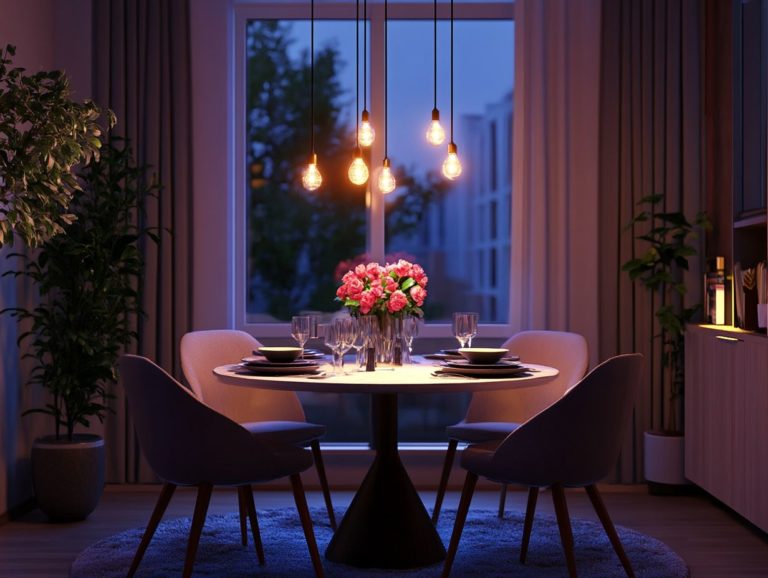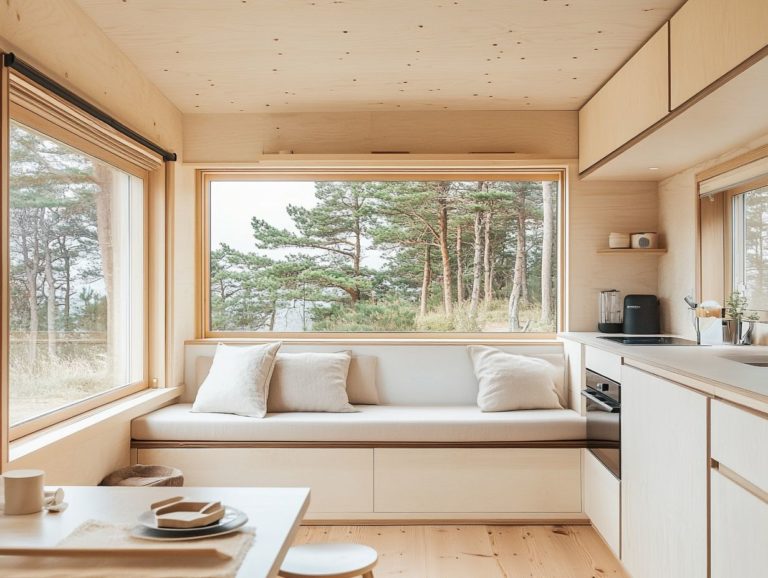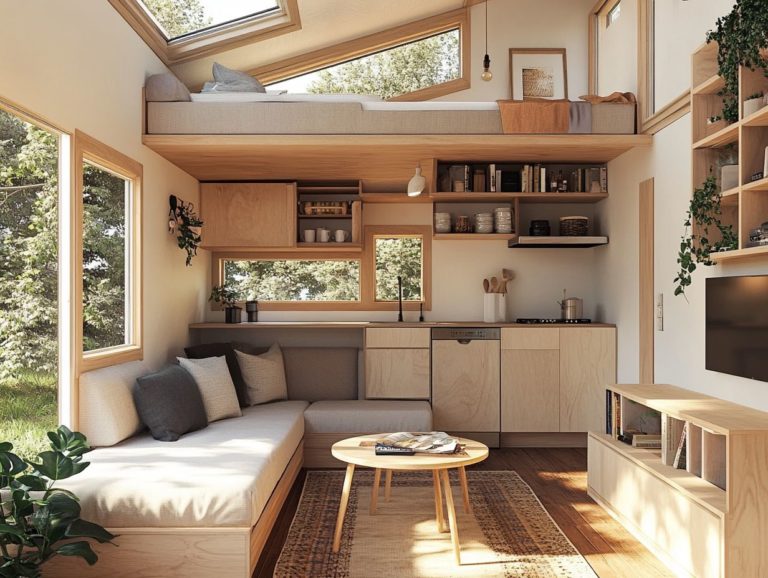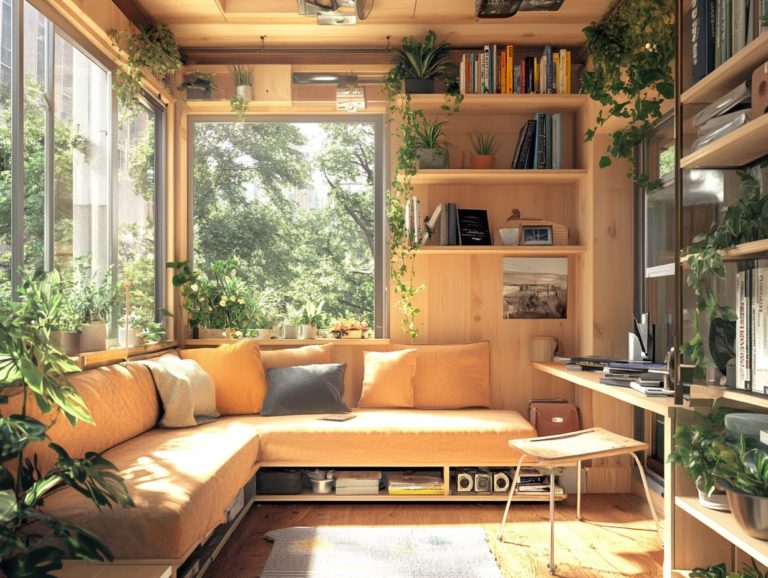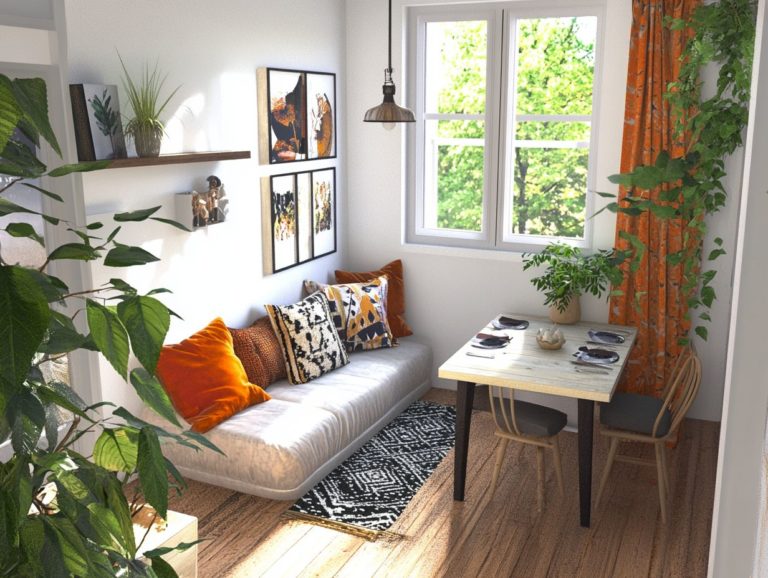How to Embrace Minimalism in Tiny Living
In a world obsessed with consumerism, minimalism offers a refreshing perspective, especially in tiny living.
This exploration delves into the essence of minimalism what it truly means and how it fits into smaller spaces. You ll discover financial benefits, reduced environmental impact, and practical tips for decluttering and maximizing your space.
We will also discuss common challenges to ensure you re fully equipped to thrive in a cozy, clutter-free home. Embracing minimalism could transform your life for the better!
Contents
- Key Takeaways:
- Defining Minimalism in Tiny Living
- Benefits of Embracing Minimalism in Tiny Living
- Practical Tips for Embracing Minimalism in Tiny Living
- Overcoming Challenges in Minimalist Tiny Living
- Frequently Asked Questions
- Curious About Minimalism and Tiny Living?
- How Can I Start Embracing Minimalism in My Tiny Living Space?
- What Are Some Benefits of Embracing Minimalism in Tiny Living?
- How can I make my tiny living space feel more spacious and less cluttered?
- Is it possible to incorporate personal style while embracing minimalism?
- How can I sustain a minimalist lifestyle in the long run?
Key Takeaways:
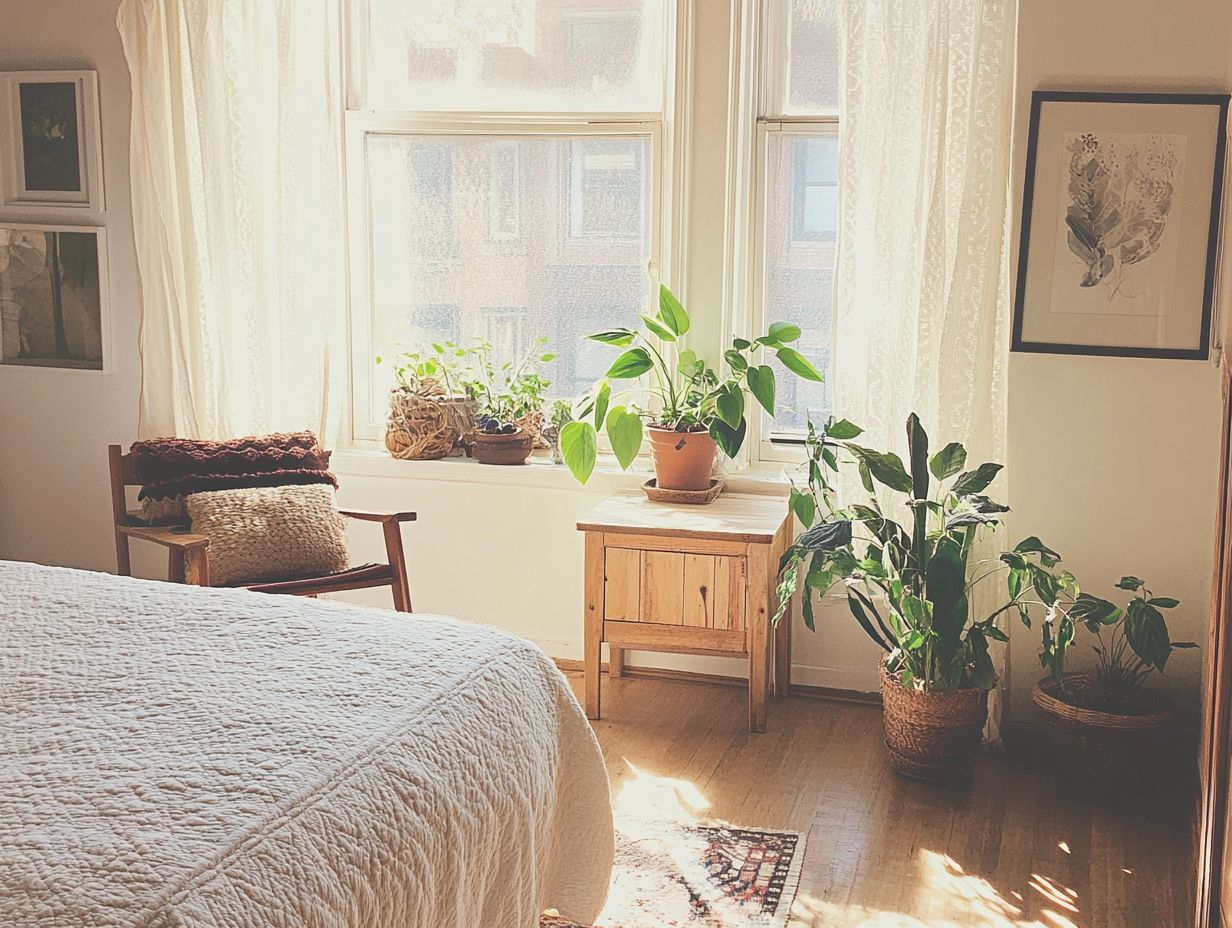
- Embrace minimalism in tiny living for less clutter and more organization.
- Save money and protect the environment by adopting a minimalist lifestyle.
- Use practical tips like decluttering and choosing multi-purpose furniture.
Defining Minimalism in Tiny Living
Minimalism in tiny living is more than just a lifestyle choice; it’s a philosophy that values quality over quantity. It encourages a clutter-free environment aligned with your emotional journey.
This philosophy shines within the tiny house movement, which aims to maximize living space while minimizing excess, promoting intentional living and sustainability.
As you adopt minimalist design principles and organization strategies, you embark on a transformative journey. You redefine what holds value in your life and consider your ecological impact, paving the way for financial freedom and a purposeful existence.
What is Minimalism?
Minimalism is a lifestyle philosophy that invites you to prioritize meaningful experiences and possessions instead of amassing items that serve no real purpose.
Rooted in various cultural traditions, minimalism underscores the belief that less truly is more. By shedding the excess, you can reveal the psychological burdens of ownership, alleviating stress and anxiety.
This liberating approach enables you to focus on relationships and experiences rather than being weighed down by possessions. Techniques like the Marie Kondo method, which encourages keeping only items that spark joy, reinforce that a clutter-free space can enhance mental clarity and overall well-being.
Ultimately, embracing minimalism leads to a more fulfilling and purposeful life.
How It Applies to Tiny Living
Applying minimalism in tiny living unfolds through furniture that can serve multiple purposes and open layouts that maximize space while nurturing a sustainable, intentional lifestyle.
In these thoughtfully designed spaces, every piece serves a dual purpose. Imagine a sofa that transforms into a bed not only a cozy spot for relaxation but also a place for guests, all while preserving your precious square footage.
Contemporary tiny houses often embrace natural materials and energy-efficient appliances, reflecting a commitment to eco-friendly living that aligns beautifully with the tiny house movement. This deliberate design invites you to assess your consumption habits and cultivate a deeper connection to your environment.
Benefits of Embracing Minimalism in Tiny Living
Embracing minimalism in tiny living presents you with numerous advantages. You’ll enjoy financial freedom as your expenses shrink, significantly reducing your ecological footprint.
This journey also enriches your emotional well-being, allowing you to cultivate deeper connections within a vibrant community.
Financial Savings
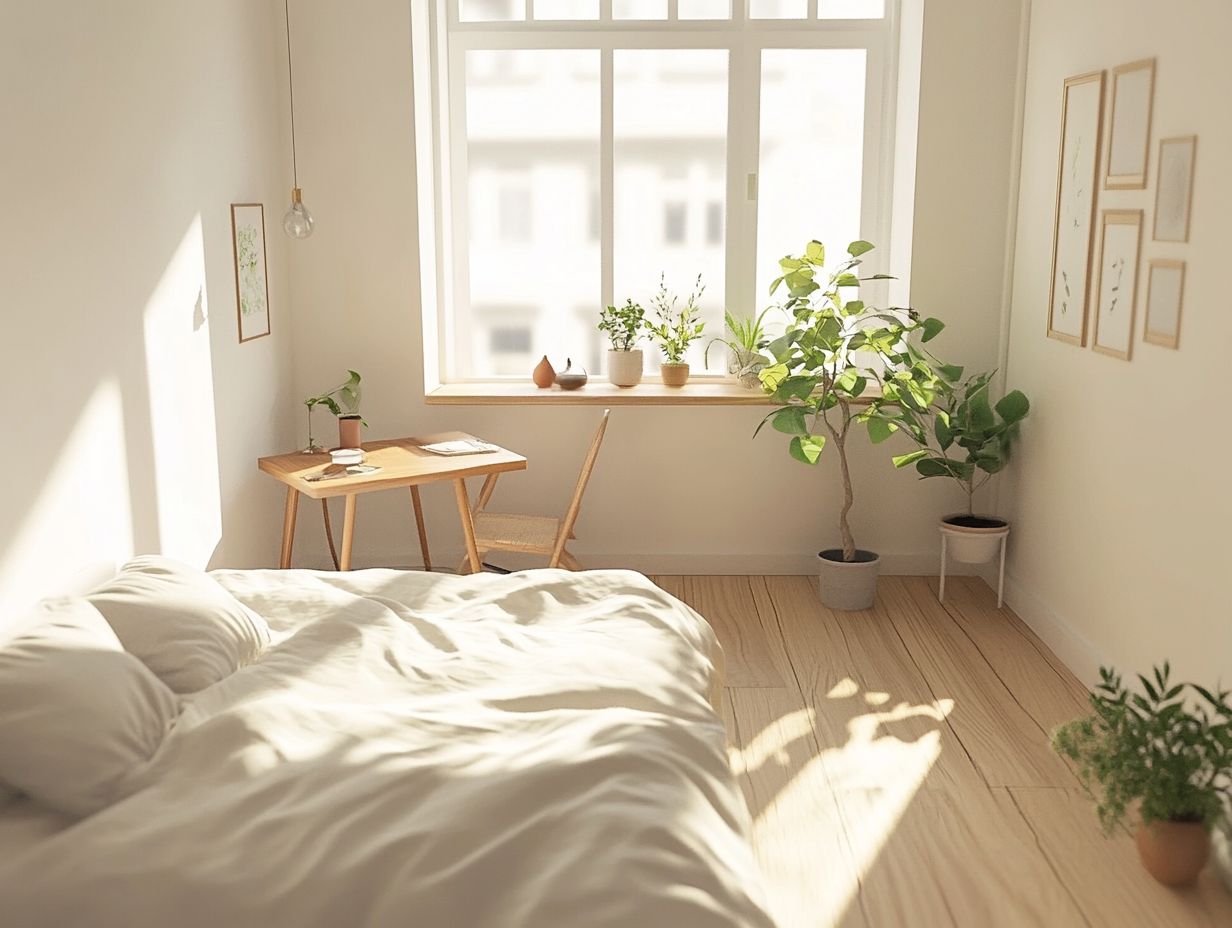
One of the most significant advantages of embracing minimalism in tiny living is the financial savings you can achieve by cutting down on expenses and adopting a more minimalist approach to spending.
Transitioning to a tiny home allows you to drastically reduce your monthly outgoings. With smaller living spaces, utility costs like electricity and water tend to be lower, leading to significant savings over time.
By embracing a minimalist mindset, you ll find yourself reevaluating your budgeting habits, often placing a premium on essential expenditures while curbing those pesky impulse purchases.
Fewer possessions mean less money spent on maintenance, insurance, and storage, which further enhances your financial outlook.
This lifestyle encourages a more intentional way of living, transforming financial freedom into a realistic goal you can actively pursue.
Environmental Impact
The environmental impact of living in a tiny home while embracing minimalism can be truly transformative. It leads to a significantly reduced ecological footprint and fosters sustainable living practices.
By limiting your space, you naturally find yourself encouraged to downsize your possessions, which not only leads to less waste but also cultivates a mindset centered on thoughtful buying.
This lifestyle minimizes the materials heading to landfills and significantly reduces energy consumption, as smaller spaces require fewer resources for heating, cooling, and maintenance.
When you adopt these principles, you often gravitate toward eco-friendly materials and energy-saving technologies, further enhancing your contribution to environmental sustainability.
Ultimately, embracing tiny living and minimalism not only benefits the planet but also inspires you and your community to rethink your relationship with consumption and the environment.
Practical Tips for Embracing Minimalism in Tiny Living
To truly embrace minimalism in tiny living, you can employ practical strategies such as:
- Thoughtful decluttering
- Optimizing your space with innovative design
- Incorporating furniture that serves more than one purpose
Each of these approaches can transform your living environment, allowing you to fully appreciate the elegance of simplicity.
Decluttering and Organizing
Decluttering and organizing are vital steps in your journey toward minimalism, especially when you embrace proven strategies like the Marie Kondo method. This approach can help you create a clutter-free wardrobe while enhancing your emotional well-being.
You may find that parting with sentimental items, such as old clothes or gifts, stirs feelings of guilt or nostalgia. The KonMari method invites you to hold each item and ask yourself whether it truly sparks joy.
This simple inquiry transforms the often overwhelming task of decluttering into a more mindful and emotionally enriching experience.
For instance, rather than merely discarding childhood memorabilia, take a moment to reflect on its significance. By considering its value, you might choose to keep a cherished piece that encapsulates those precious memories.
These practices not only streamline your physical spaces but also foster mental clarity, encouraging a healthier relationship with your possessions.
Maximizing Space
Maximizing space in your tiny home is essential for comfortable living. You can achieve this through the strategic use of multifunctional furniture and an open layout that promotes both fluidity and efficiency.
By thoughtfully considering how each area is utilized, you can create an inviting environment that feels more expansive than it actually is. This means choosing furniture pieces that serve multiple purposes like a sofa that effortlessly converts into a bed or a dining table that doubles as a workspace.
Incorporating vertical storage solutions will significantly enhance your spatial organization, allowing you to store items neatly while maintaining a clean and elegant aesthetic.
The arrangement of your furniture is crucial as well. A well-planned layout encourages movement and interaction, making even the coziest spaces feel warm and functional.
Choosing Multifunctional Furniture
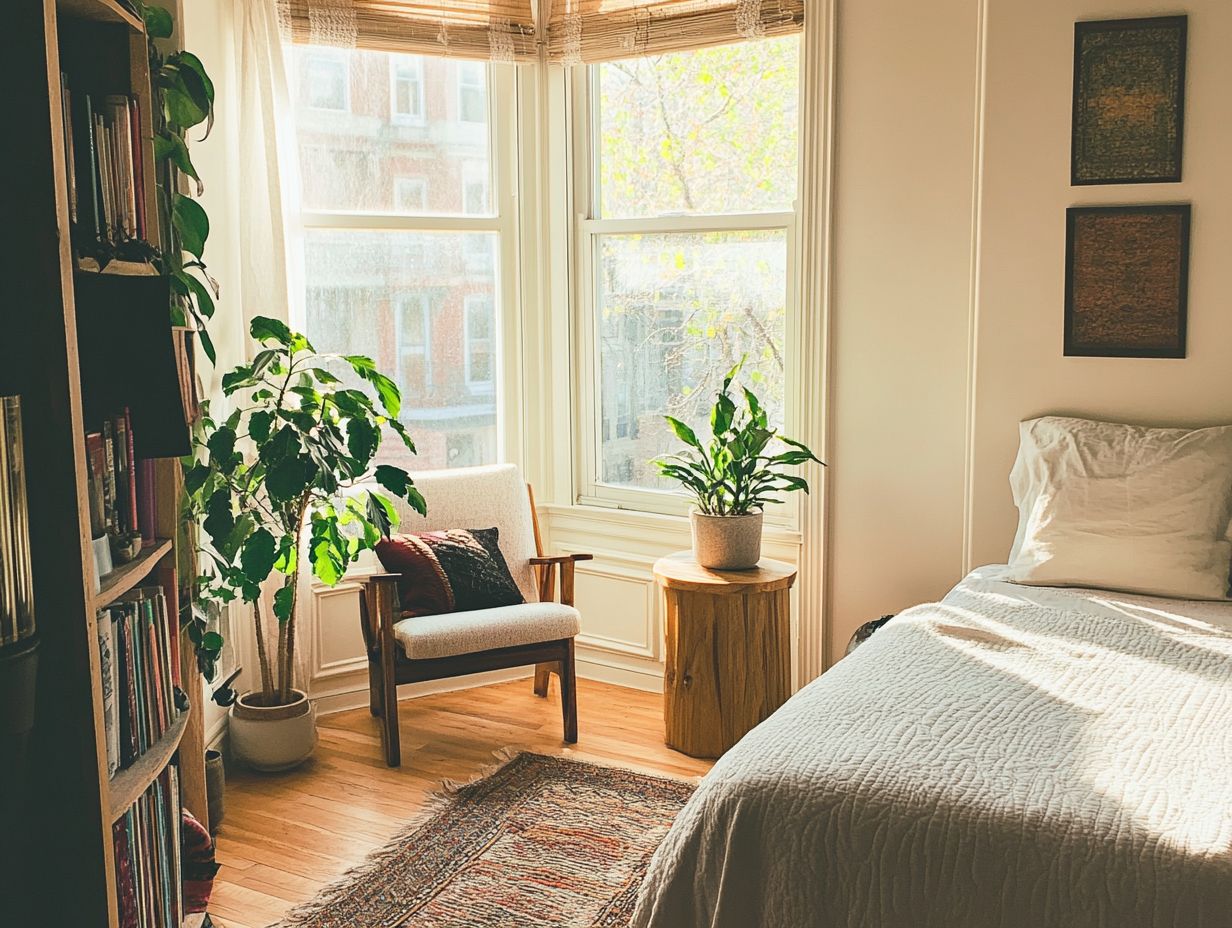
Choosing multifunctional furniture is a savvy move toward creating an efficient and organized tiny home lifestyle. This enables you to save space while keeping your home aesthetically pleasing.
This innovative approach maximizes your limited square footage and enhances both comfort and functionality. For instance, imagine a foldable dining table that transforms into a workstation. This allows for a smooth transition from enjoying meals to diving into productivity.
Consider a sofa that converts into a bed, providing a cozy spot for relaxation during the day and a comfortable sleeping area at night. By incorporating such versatile designs, you can foster a clutter-free environment while showcasing your personal style. Make every square inch in your compact living space count!
Overcoming Challenges in Minimalist Tiny Living
While the allure of minimalist tiny living offers a wealth of benefits, you ll discover exciting challenges along the way! Limited storage can test your organizational skills, and the emotional journey of managing your personal belongings can be quite profound as you embrace a minimalist lifestyle.
Dealing with Limited Storage
Dealing with limited storage in tiny homes demands creative ways to organize your space that seamlessly blend multifunctional furniture with a clutter-free wardrobe.
To truly maximize your space and cultivate a serene environment, think beyond conventional storage solutions. Opt for ottomans that double as storage bins or beds with built-in drawers. These choices enhance usability while keeping your essentials neatly tucked away.
Embrace vertical space through wall-mounted shelves or pegboards to create an illusion of spaciousness. This allows you to display personal items neatly without overwhelming your living area. By adopting these creative approaches, anyone residing in a tiny home can transform limited square footage into an organized haven. For more inspiration, check out these minimalist decor ideas for tiny houses, artfully balancing functionality and style.
Managing Personal Belongings
Managing your personal belongings in a minimalist tiny living space can feel like an emotional rollercoaster. This necessitates effective decluttering strategies that resonate with a minimalist lifestyle.
This journey often uncovers feelings of attachment, nostalgia, and even a twinge of guilt as you consider parting with items that once held significant meaning. It s essential to acknowledge that each possession has its own narrative. However, embracing a tiny living philosophy requires you to weigh these stories against your practical needs and spatial constraints.
To navigate this emotional landscape, start by categorizing your belongings into essentials and non-essentials. This promotes intentional decision-making about what truly deserves a place in your life. Approaching decluttering with mindfulness can facilitate emotional healing, allowing you to release physical items that no longer serve a purpose.
Frequently Asked Questions
Curious About Minimalism and Tiny Living?
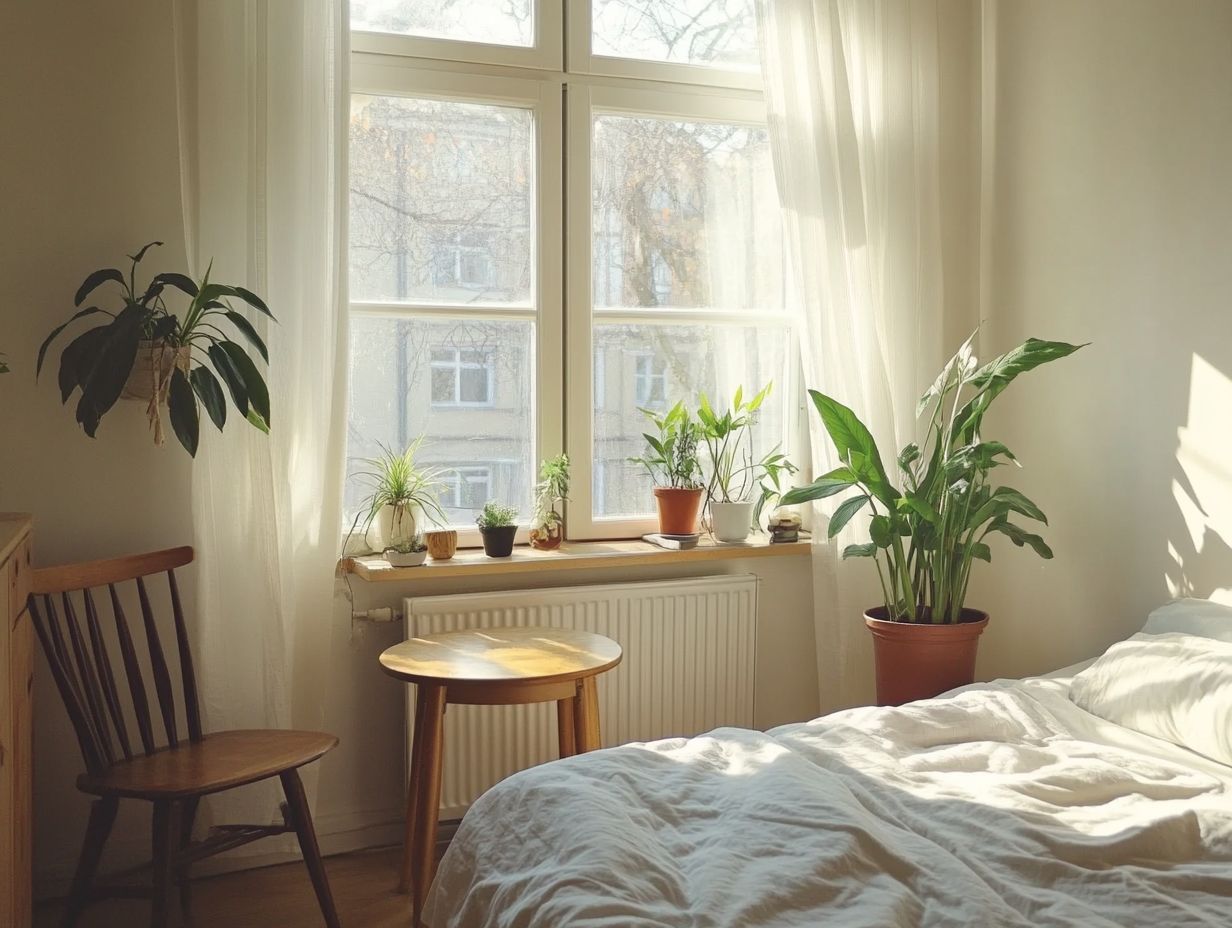
Minimalism is a lifestyle that focuses on owning and using only the essentials to live a simpler and less cluttered life. In the context of tiny living, minimalism is essential as it allows for maximum use of limited space and promotes a more intentional and sustainable way of living.
How Can I Start Embracing Minimalism in My Tiny Living Space?
First, take a step back and evaluate your current possessions. Ask yourself if each item serves a purpose or brings you joy. Begin decluttering and keep only the items that are necessary or hold meaningful value to you.
What Are Some Benefits of Embracing Minimalism in Tiny Living?
Embracing minimalism in tiny living can save you money, reduce stress, and improve your overall well-being. It allows for more flexibility and freedom in terms of location and helps you appreciate the little things in life.
What multifunctional furniture piece will you choose first?
How can I make my tiny living space feel more spacious and less cluttered?
Utilize storage solutions such as vertical shelving and multi-functional furniture.
Avoid buying unnecessary items. Regularly declutter to maintain a spacious and open area.
Is it possible to incorporate personal style while embracing minimalism?
Yes! Minimalism doesn t mean living in a bare environment.
You can express your personality through thoughtfully selected decor that enhances your space.
How can I sustain a minimalist lifestyle in the long run?
Embracing minimalism is an ongoing journey.
Constantly evaluate your possessions and make smart choices about new items. Regularly reassess your priorities to enjoy the benefits of living with less!

